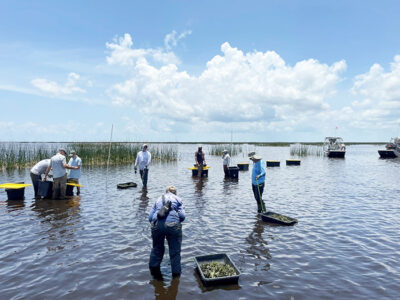FWC completes revegetation projects on Lake Okeechobee

This spring, the Florida Fish and Wildlife Conservation Commission completed a revegetation effort on Lake Okeechobee, enhancing the habitat in Fisheating Bay, Moore Haven Marsh and the Fisheating Bay islands. These revegetation efforts are in part guided by the Lake Okeechobee Fish, Wildlife and Habitat Management Plan, developed in 2022 to help more aquatic species meet management goals.
Lake Okeechobee’s aquatic plants have struggled due to prolonged high-water levels, impacts resulting from both natural and human disturbances. Strong winds and heavy rainfall associated with tropical events can uproot plants and lead to these prolonged high lake stages. Extended periods of high water can increase turbidity, reducing light penetration for submerged plants and changing the aquatic plant community, preventing germination and spread of aquatic plants. Loss of submerged aquatic vegetation (SAV) can severely impact an ecosystem, as SAV provides vital breeding grounds, shelter, and food for many species of fish and wildlife.
To combat this, the FWC partnered with the South Florida Water Management District to plant 40,000 individual eelgrass (tapegrass), paspaladium (Kissimmee grass), and bulrush plants resulting in 8.25 acres of improved habitat. The grasses were planted in less than 1 foot of water to allow for the rise of the lake stage through summer. These native aquatic plants will provide habitat for several native fish and wildlife species, including the endangered Everglade snail kite.
Wildlife habitat in the Moore Haven marsh was enhanced by planting 27,558 individual sawgrass plants across 6 acres. Sawgrass has been in decline due to encroachment from cattail and willow, along with high water, which suppresses the prescribed fire that sawgrass relies on. Sawgrass provides shelter for the threatened Eastern black rail and nesting habitat for alligators. The seeds are a high-quality food source for waterfowl.
To enhance wading bird rookeries on the Fisheating Bay Islands, the FWC also planted 100 each of pond apple, pop ash and bald cypress, and 80 cocoplums spread over seven islands.
The low lake stages in 2025 have led to increased water clarity, which will allow the new plantings to flourish in these areas, bolstering the coverage of these historically important grasses for the benefit of fish, wildlife, anglers, hunters and wildlife viewers. If you have any questions regarding the restoration on Lake Okeechobee, visit MyFWC.com/AquaticHabitats or email AquaticHabitat@MyFWC.com.

